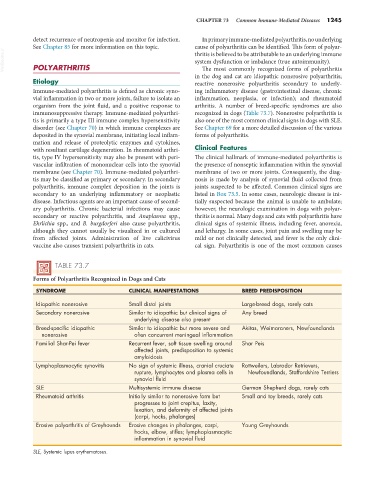Page 1273 - Small Animal Internal Medicine, 6th Edition
P. 1273
CHAPTER 73 Common Immune-Mediated Diseases 1245
detect recurrence of neutropenia and monitor for infection. In primary immune-mediated polyarthritis, no underlying
See Chapter 85 for more information on this topic. cause of polyarthritis can be identified. This form of polyar-
VetBooks.ir POLYARTHRITIS thritis is believed to be attributable to an underlying immune
system dysfunction or imbalance (true autoimmunity).
The most commonly recognized forms of polyarthritis
in the dog and cat are idiopathic nonerosive polyarthritis;
Etiology reactive nonerosive polyarthritis secondary to underly-
Immune-mediated polyarthritis is defined as chronic syno- ing inflammatory disease (gastrointestinal disease, chronic
vial inflammation in two or more joints, failure to isolate an inflammation, neoplasia, or infection); and rheumatoid
organism from the joint fluid, and a positive response to arthritis. A number of breed-specific syndromes are also
immunosuppressive therapy. Immune-mediated polyarthri- recognized in dogs (Table 73.7). Nonerosive polyarthritis is
tis is primarily a type III immune complex hypersensitivity also one of the most common clinical signs in dogs with SLE.
disorder (see Chapter 70) in which immune complexes are See Chapter 69 for a more detailed discussion of the various
deposited in the synovial membrane, initiating local inflam- forms of polyarthritis.
mation and release of proteolytic enzymes and cytokines,
with resultant cartilage degeneration. In rheumatoid arthri- Clinical Features
tis, type IV hypersensitivity may also be present with peri- The clinical hallmark of immune-mediated polyarthritis is
vascular infiltration of mononuclear cells into the synovial the presence of nonseptic inflammation within the synovial
membrane (see Chapter 70). Immune-mediated polyarthri- membrane of two or more joints. Consequently, the diag-
tis may be classified as primary or secondary. In secondary nosis is made by analysis of synovial fluid collected from
polyarthritis, immune complex deposition in the joints is joints suspected to be affected. Common clinical signs are
secondary to an underlying inflammatory or neoplastic listed in Box 73.5. In some cases, neurologic disease is ini-
disease. Infectious agents are an important cause of second- tially suspected because the animal is unable to ambulate;
ary polyarthritis. Chronic bacterial infections may cause however, the neurologic examination in dogs with polyar-
secondary or reactive polyarthritis, and Anaplasma spp., thritis is normal. Many dogs and cats with polyarthritis have
Ehrlichia spp., and B. burgdorferi also cause polyarthritis, clinical signs of systemic illness, including fever, anorexia,
although they cannot usually be visualized in or cultured and lethargy. In some cases, joint pain and swelling may be
from affected joints. Administration of live calicivirus mild or not clinically detected, and fever is the only clini-
vaccine also causes transient polyarthritis in cats. cal sign. Polyarthritis is one of the most common causes
TABLE 73.7
Forms of Polyarthritis Recognized in Dogs and Cats
SYNDROME CLINICAL MANIFESTATIONS BREED PREDISPOSITION
Idiopathic nonerosive Small distal joints Large-breed dogs, rarely cats
Secondary nonerosive Similar to idiopathic but clinical signs of Any breed
underlying disease also present
Breed-specific idiopathic Similar to idiopathic but more severe and Akitas, Weimaraners, Newfoundlands
nonerosive often concurrent meningeal inflammation
Familial Shar-Pei fever Recurrent fever, soft tissue swelling around Shar Peis
affected joints, predisposition to systemic
amyloidosis
Lymphoplasmacytic synovitis No sign of systemic illness, cranial cruciate Rottweilers, Labrador Retrievers,
rupture, lymphocytes and plasma cells in Newfoundlands, Staffordshire Terriers
synovial fluid
SLE Multisystemic immune disease German Shepherd dogs, rarely cats
Rheumatoid arthritis Initially similar to nonerosive form but Small and toy breeds, rarely cats
progresses to joint crepitus, laxity,
luxation, and deformity of affected joints
(carpi, hocks, phalanges)
Erosive polyarthritis of Greyhounds Erosive changes in phalanges, carpi, Young Greyhounds
hocks, elbow, stifles; lymphoplasmacytic
inflammation in synovial fluid
SLE, Systemic lupus erythematosus.

